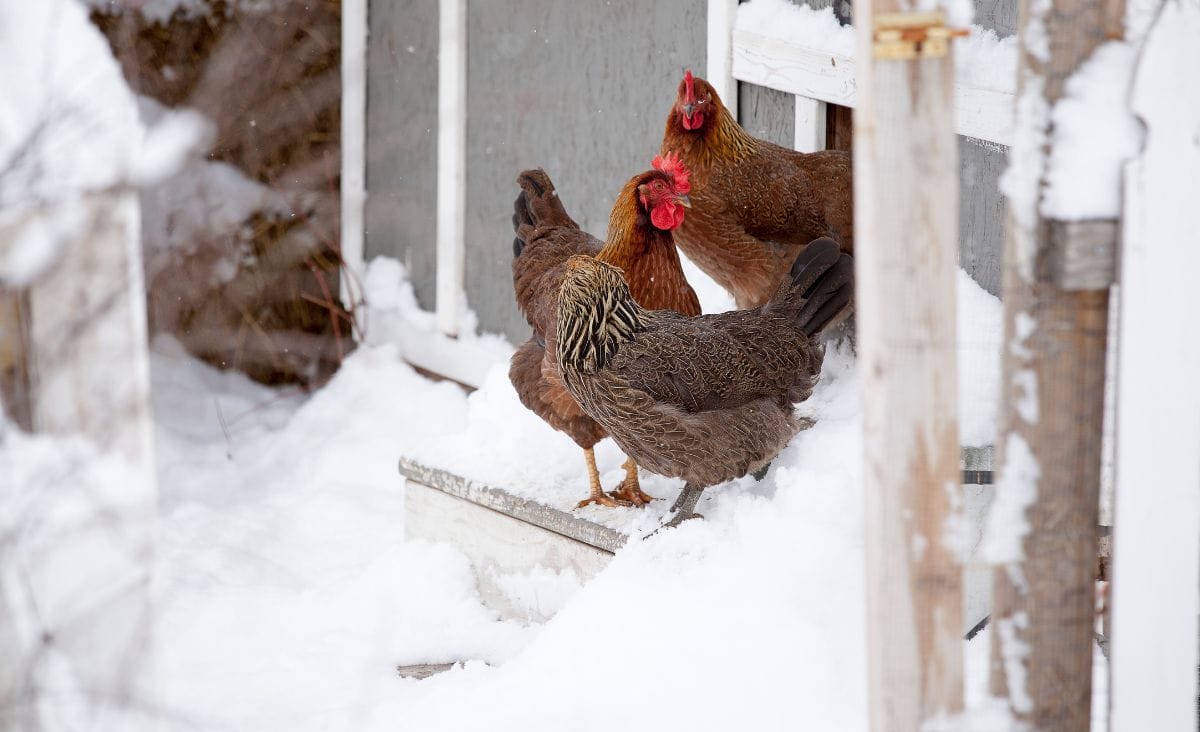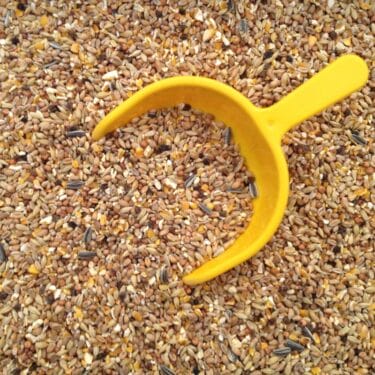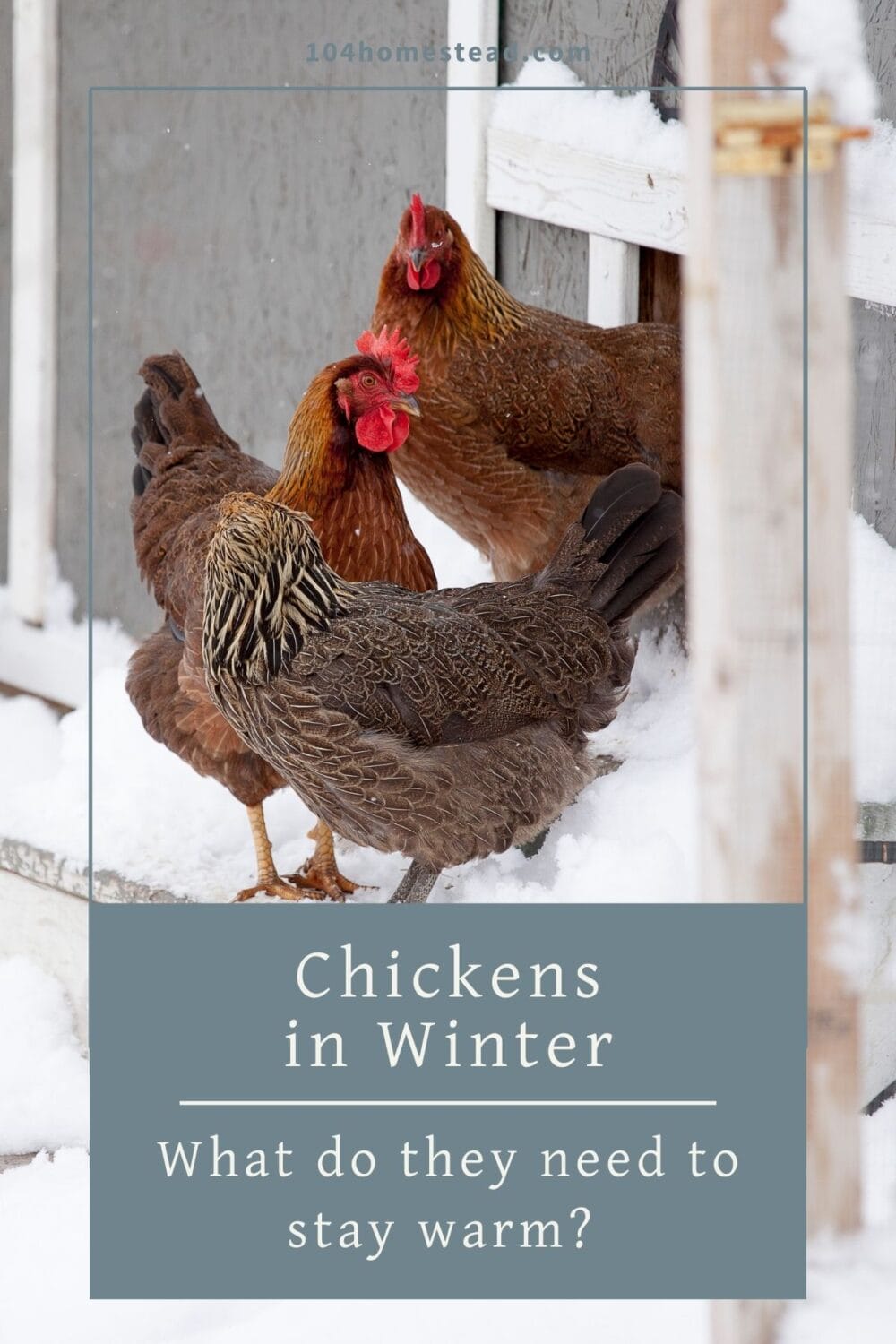Chickens In Winter: What Do They Need to Stay Warm?
Care for your chickens correctly in the winter. Make sure to provide what chickens need with common-sense steps to keep them safe and warm.

Chickens can have a hard time in the winter, but with a few smart steps, they can get through it without too much trouble. Additionally, I’ll dispel common misconceptions by describing two practices that are not only unnecessary but could potentially harm your feathered companions.
Let’s explore the main things that will make your hens happy during the winter months.
What Your Chickens Need This Winter
As winter approaches, you need to make sure your chickens are healthier than ever. Some breeds, like Barred Rocks, Delawares, Brahmas, Salmon Favorelles, Rhode Island Reds, and New Hampshire Reds, naturally do well in the winter. Still, even the toughest breeds appreciate some help every once in a while.
Not sure what breed your chicken is? I can help!
Find out what they need to know to have a comfortable and successful winter. If you give your birds a warm, well-ventilated coop, winterized outdoor areas, and healthy treats, they will be happy during the cold months.
Dry, Well-Ventilated Coop
You should give your chickens a dry, draft-free place to sleep. Cover the floor of the coop with a thick layer of straw. Close the windows to keep drafts out, but leave the vents open so that the coop can breathe. Having enough air flow helps keep moisture from building up, which is a major cause of frostbite. Thankfully, it’s easy to prepare your coop for winter.
Are you designing your first chicken coop? Get it right the first time!
A lot of people want to know if they should insulate their chicken coops. There are pros and cons to insulating your chicken coop, and the choice depends on a number of factors.
Pros of Insulating Your Chicken Coop
- Temperature Regulation: Insulation helps in maintaining a more stable temperature inside the coop, protecting your chickens from extreme cold.
- Energy Efficiency: During colder months, insulation can reduce the need for additional heating, potentially saving on energy costs.
- Reduced Moisture: Proper insulation can mitigate moisture buildup, decreasing the risk of frostbite and respiratory issues among your chickens.
Cons of Insulating Your Chicken Coop
- Ventilation Challenges: Insulation may hinder natural ventilation if not appropriately balanced, leading to stagnant air and increased humidity, which can be harmful.
- Initial Cost: Insulating a coop can cost a lot of money.
- Maintenance Issues: Insulation may attract rodents seeking nesting material, potentially leading to maintenance challenges.
I live in the mountain valleys of Maine. In fact, the very lowest temperature of the day is often reported for the area where I live in Maine. We have never had a problem with our chicken, quail, or duck coops staying warm without insulation.
A Winterized Run
Encourage outdoor activity by creating a winter-friendly run. Get the chickens outside by giving them perches, branches, benches, or straw. Wrapping portions of the run in tarps or transparent plastic will provide wind protection.
If you free-range your chickens and don’t have a run, that’s not a problem! Let your chickens roam freely even in the winter, as explained in Where to Free Range Chickens in Winter, which highlights the value of natural behaviors and mental stimulation for the flock. This post gives useful advice on how to support free-range activities in snowy places, including ways to keep animals from getting frostbite and giving them other places to scratch and dust bathe.
Warming, Energizing Snacks
Although regular feed should be their main source of food, give your chickens scratch grains before bedtime. This helps generate energy for warmth. You can also add more protein and fat with suet, whether you buy it or make it yourself.

High-Fat, High-Protein Chicken Scratch Recipe
This post may contain paid links. If you make a purchase using the links in this recipe, I may earn a commission.
Equipment
- 1 Airtight Container
Ingredients
- 2 c. Whole Corn
- 1 c. Sunflower Seeds
- 1 c. Dried Mealworms
- ½ c. Flaxseeds
- ½ c. Pumpkin Seeds unsalted
- ¼ c. Peanuts unsalted
- ¼ c. Chia Seeds
Instructions
- In a large mixing bowl, combine the whole corn, sunflower seeds, dried mealworms, flaxseeds, pumpkin seeds, peanuts, and chia seeds.2 c. Whole Corn, 1 c. Sunflower Seeds, 1 c. Dried Mealworms, 1/2 c. Flaxseeds, 1/2 c. Pumpkin Seeds, 1/4 c. Peanuts, 1/4 c. Chia Seeds
- Mix the ingredients thoroughly, ensuring an even distribution of each component.
- Store the high-fat, high-protein chicken scratch in an airtight container in a cool, dry place.
- Offer this nutrient-rich mix to your backyard chickens as a supplement to their regular feed.
Notes
Fresh (Unfrozen) Water
Even in the winter, chickens need to be able to get fresh water all day long. Consider using an electric dog water bowl to prevent freezing.
Without electricity, you have to get creative to keep chicken water from freezing. Insulating materials like foam or hay can be used to make a cover or shelter for the water container.
Another way to keep the waterer warm is to wrap it in an old blanket or burlap bag. A floating object, like a small ball, can also stop ice from forming.
You can also keep it from freezing by adding warm water on a regular basis or using a container with good insulation. Check the water often and add fresh water so your chickens can always get to water that is not frozen.
Tip: If you want to keep eggs from freezing in the winter, collect them quickly, preferably several times a day. Also, fill nesting boxes with straw or hay to keep them warm, and use golf balls or ceramic eggs to get the hens to lay their eggs in a central, warmer area of the coop.
What Your Chickens Don’t Need This Winter
Offering your chickens the right winter necessities is important, but it is also important to know what they do not need during the colder months.
This part will bust some common myths and explain two things that, despite what most people think, you do not need to do and might actually be bad for your flock’s health in the winter. Let us separate fact from fiction and make sure your chickens have a healthy and happy season.
Say No to Heat
For safety reasons, do not use heat lamps or radiant panel heaters in the coop. Heat lamps can start coop fires, and relying on heat stops chickens from naturally getting used to the cold.
Also, heating creates moisture, which is bad for the health of your flock.
Say No to Chicken Sweaters
Do not knit your chickens sweaters. It is natural for chickens to keep their bodies at the right temperature by fluffing their feathers. Wearing sweaters stops them from doing this. Even during molting, chickens don’t benefit from sweaters, as they could be uncomfortable and possibly painful as the new feathers grow in.
Frequently Asked Questions
If you’ve found value in this blog post and enjoyed reading it, why not share it with your Pinterest community? Pin the image below and spread the love!

Remember, keeping it simple is key to ensuring your chickens’ well-being during the winter months. All they really need to do well is a dry coop, a comfortable run, healthy snacks, and water that is not frozen. Stop doing things that are not necessary, like heating and chicken sweaters, and your birds will be happier and healthier.
What winter care practices have worked best for your chickens? Share your insights or any unique strategies you’ve employed to keep your flock comfortable during the colder months.

